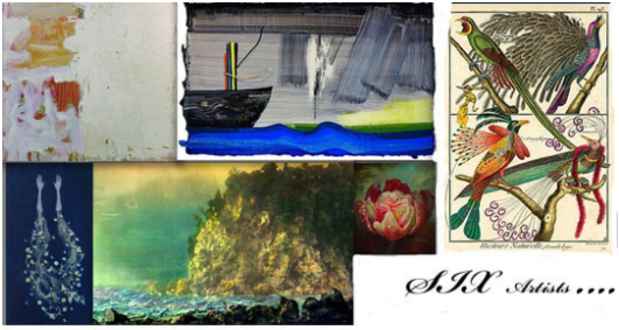"SIX artists" Exhibition
Littlejohn Contemporary

This event has ended.
Littlejohn Contemporary presents the exhibition, SIX artists.
SIX artists features a small group of contemporary artists impelled by Nature-based inspiration and imagery who work in a variety of mediums including photography, mixed media print, painting and drawing. The artists include Valerie Hammond, Kim Keever, Ruth Marten, Jacquelyn McBain, Jennifer Wynne Reeves and Melinda Stickney-Gibson.
Valerie Hammond’s encaustic-encased mixed media drawings have a poignant, haunting presence. Looking at parts of the body and how they function in relation to portraiture is a primary part of her work. Her oft-used images of hands refer to aging and life cycles. The artist draws inspiration from religious effigies, devotional objects, and the enchantment of nature. A sense of the spirit world is palpable in her work. Hammond links her imagery to personal themes of memory, youth and death. Bats hover, stems intertwine, and birds mesh with butterflies and flowers. The natural world’s cyclical disintegration and regrowth suggests a kind of universal story-telling, the seasons providing beginning and end.
Kim Keever's photographs are created by meticulously constructing miniature topographies in a 200-gallon tank which is then filled with water. His dioramas of fictitious environments are brought to life with colored light filters and the dispersal of pigment, producing ephemeral atmospheres that he must quickly capture with his large-format camera. Keever's painterly photographic panoramas represent a continuation of the landscape tradition, as well as an evolution of the genre. Referencing a broad history of landscape painting, especially that of Romanticism and the Hudson River School, they are imbued with a sense of the sublime. However, they also show a subversive side that deliberately acknowledges their contemporary contrivance and conceptual artifice.
Ruth Marten 's drawings occupy and enact upon the historical spaces of vintage prints by detourning them with the precision of the tattoo artist. Delicate, controlled and highly illusionistic, they utilize the trope of the visual malaprop to create an imaginary third space in which surreal and subversive narratives are entwined. Central to Marten's work is the idea that the visual classificatory systems and conventions of natural history and encyclopedic illustrations are inherently partial and unstable, and she exploits this knowledge to create a surreal and subversive world in which hip-hop Phoenicians can co-exist with hirsute Counts.
Jacquelyn McBain’s small paintings on masonite reflect a return to the Old Masters in giving us beautifully crafted paintings that become reliquaries and greenhouses that portray a sense of the sacred and the sacredness of beauty. McBain’s choice of the 17th century Dutch painters as mentors for her paintings presents the viewer with a modernist devotional form. The artist paints a deeply felt response to nature while adding images from dreams and scientific inquiry. Her works have a surreal narrative quality comprised of sumptuous compositions that seem to glow from within. McBain’s reflections convey the value she places on Nature and the insights gleaned from close examination of it. Her sense of wonder at nature and regard for the sense of ritual constructed by man around the core of life’s meaning reveal her innate sense of relationship and affiliation with other living things. McBain takes the ecological doorway into symbolic thought, sees the menagerie in the self and finds the alluring detail with instructive generality. These are counselors that feelingly persuade and now, small animals, birds and a rarely seen pika are the occupiers of her eye.
Jennifer Wynne Reeves’ artwork offers a pictorial hybrid of color, pattern, whimsy and intelligence. Her work combines abstract elements with figuration. She presents viewers with a savvy, satirical world that combines abstraction and representation in an open-ended narrative. Reeves emphasizes the sensual and appealing nature of lushly rendered surfaces, colors and forms. Though an abstract painter on many levels, she remains ostensibly loyal to art’s original historic purpose to describe recognizable figures and tell their story. Reeves reverses the traditional painterly course that evolves figuration into abstraction. Instead, evolving abstraction into figuration, she creates a cast of abstract characters infusing them with the power of representational storytelling. They appear and re-appear like actors on a stage playing roles. These ambiguous motifs may suggest good or evil aspects, they may be victim or predator, as they obliquely reveal aspects of the artist’s life and experience.
For Melinda Stickney-Gibson, painting is like life - messy, full of accidents and underlain with semi-orderly structures that bend and disintegrate under pressure of real life action.
Her lyrical paintings are not so much painted as allowed to evolve, growing by accretion over periods of weeks or months (or at times, even years), as loose brushstrokes are laid over looser grids, fields of color laid down to partially obscure sketchy marks, and traces of covered layers revealed by a subtle cut through the surface. These works are rife with hints of the nature-based abstract expressionism of Joan Mitchell, the atmospheric fields of Whistler, and the analytic reductiveness of Robert Ryman. As in the work of those artists, the final compositions are full of evidence of the process that created them, yielding a subtle complexity that could never have been envisioned at the beginning.
Media
Schedule
from April 11, 2013 to May 11, 2013
Opening Reception on 2013-04-11 from 18:00 to 20:00